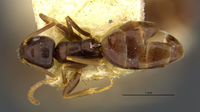Tapinoma amazonae
| Tapinoma amazonae | |
|---|---|

| |
| Scientific classification | |
| Kingdom: | Animalia |
| Phylum: | Arthropoda |
| Class: | Insecta |
| Order: | Hymenoptera |
| Family: | Formicidae |
| Subfamily: | Dolichoderinae |
| Genus: | Tapinoma |
| Species: | T. amazonae |
| Binomial name | |
| Tapinoma amazonae Wheeler, W.M., 1934 | |
Identification
This species is quite distinct from Tapinoma atriceps in size, shape of head, coloration, etc., and is much more like the common North American Tapinoma sessile, but the head is shorter and the shape of the thorax and the coloration are quite different. (Wheeler 1934)
Distribution
Latitudinal Distribution Pattern
Latitudinal Range: -1.456° to -4°.
| North Temperate |
North Subtropical |
Tropical | South Subtropical |
South Temperate |
- Source: AntMaps
Distribution based on Regional Taxon Lists
Neotropical Region: Brazil (type locality).
Distribution based on AntMaps
Distribution based on AntWeb specimens
Check data from AntWeb
Countries Occupied
| Number of countries occupied by this species based on AntWiki Regional Taxon Lists. In general, fewer countries occupied indicates a narrower range, while more countries indicates a more widespread species. |

|
Estimated Abundance
| Relative abundance based on number of AntMaps records per species (this species within the purple bar). Fewer records (to the left) indicates a less abundant/encountered species while more records (to the right) indicates more abundant/encountered species. |

|
Biology
Castes
Nomenclature
The following information is derived from Barry Bolton's Online Catalogue of the Ants of the World.
- amazonae. Tapinoma amazonae Wheeler, W.M. 1934g: 185 (w.) BRAZIL.
Unless otherwise noted the text for the remainder of this section is reported from the publication that includes the original description.
Description
Worker
Length 2.5-3 mm.
Head slightly longer than broad, somewhat broader behind than in front, with moderately, evenly convex sides and straight, transverse border. Eyes rather large and convex, as long as their distance from the anterior corners of the head. Clypeus convex in the middle, its anterior border rounded and entire in the middle and slightly sinuate on each side; its posterior suture rather indistinct. Frontal area and groove absent; frontal carina: short, subparallel, slightly farther apart than their distance from the lateral borders of the head. Mandibles stout, convex, their oblique terminal borders with about 10 or 11 teeth, the first, second and fourth from the tip large, the others minute, subequal denticles. Antennae rather stout, scapes extending nearly one fourth their length beyond the posterior border of the head; funicular joints 2-4 one and one-half times as long as broad, joints 5-10 shorter but distinctly longer than broad, last joint as long as the two preceding joints together. Thorax rather short, its dorsal outline in profile straight and horizontal in the middle; promesonotal suture impressed; mesoepinotal impression deeper and acute; seen from above the pronotum is short, one and one-half times as broad as long, with convex humeri, mesonotum somewhat longer than broad, not rising above the pronotum; base of the latter convex, very short, not more than a fourth as long as the straight, flat, sloping declivity, which from behind is semicircularly rounded above with straight ventrally diverging sides. Petiole elliptical, narrow, twice as long as broad, flattened above, with only a vestige of a node at its anterior end. Gaster large, not pointed posteriorly. first segment overlying and concealing the petiole. Legs moderately long.
Shining and very finely and evenly punctulate or reticulate; mandibles smoother, sparsely and coarsely punctate.
Hairs and pubescence yellowish; the former present only on the mandibles and clypeus, the latter short but dilute on the body, most distinct on the gaster, thorax and sides of head but not concealing the surface, shorter on the appendages, dense on the tibiae.
Brown, head darker and more blackish, especially behind; mandibles, mouthparts, sides of clypeus, antenna: and legs, including the coxae, brownish yellow.
Type Material
Described from a number of workers taken many years ago by Prof. C. F. Baker at Para, Brazil.
References
- Albuquerque, E., Prado, L., Andrade-Silva, J., Siqueira, E., Sampaio, K., Alves, D., Brandão, C., Andrade, P., Feitosa, R., Koch, E., Delabie, J., Fernandes, I., Baccaro, F., Souza, J., Almeida, R., Silva, R. 2021. Ants of the State of Pará, Brazil: a historical and comprehensive dataset of a key biodiversity hotspot in the Amazon Basin. Zootaxa 5001, 1–83 (doi:10.11646/zootaxa.5001.1.1).
- Wheeler, W. M. 1934g. Neotropical ants collected by Dr. Elisabeth Skwarra and others. Bulletin of the Museum of Comparative Zoology 77: 157-240 (page 185, worker described)
References based on Global Ant Biodiversity Informatics
- Kempf, W.W. 1972. Catalago abreviado das formigas da regiao Neotropical (Hym. Formicidae) Studia Entomologica 15(1-4).
- Lopes M. C., G. P. A. Lamarre, C. Baraloto, P. V. A. Fine, A. Vincentini, and F. B. Baccaro. 2019. The Amazonas-trap: a new method for sampling plant-inhabiting arthropod communities in tropical forest understory. Entomologia Experimentalis et Applicata https://doi.org/10.1111/eea.12797

